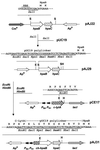Functional analysis of the small component of the 4-hydroxyphenylacetate 3-monooxygenase of Escherichia coli W: a prototype of a new Flavin:NAD(P)H reductase subfamily
- PMID: 10633095
- PMCID: PMC94324
- DOI: 10.1128/JB.182.3.627-636.2000
Functional analysis of the small component of the 4-hydroxyphenylacetate 3-monooxygenase of Escherichia coli W: a prototype of a new Flavin:NAD(P)H reductase subfamily
Abstract
Escherichia coli W uses the aromatic compound 4-hydroxyphenylacetate (4-HPA) as a sole source of carbon and energy for growth. The monooxygenase which converts 4-HPA into 3,4-dihydroxyphenylacetate, the first intermediate of the pathway, consists of two components, HpaB (58.7 kDa) and HpaC (18.6 kDa), encoded by the hpaB and hpaC genes, respectively, that form a single transcription unit. Overproduction of the small HpaC component in E. coli K-12 cells has facilitated the purification of the protein, which was revealed to be a homodimer that catalyzes the reduction of free flavins by NADH in preference to NADPH. Subsequently, the reduced flavins diffuse to the large HpaB component or to other electron acceptors such as cytochrome c and ferric ion. Amino acid sequence comparisons revealed that the HpaC reductase could be considered the prototype of a new subfamily of flavin:NAD(P)H reductases. The construction of a fusion protein between the large HpaB oxygenase component and the choline-binding domain of the major autolysin of Streptococcus pneumoniae allowed us to develop a rapid method to efficiently purify this highly unstable enzyme as a chimeric CH-HpaB protein, which exhibited a 4-HPA hydroxylating activity only when it was supplemented with the HpaC reductase. These results suggest the 4-HPA 3-monooxygenase of E. coli W as a representative member of a novel two-component flavin-diffusible monooxygenase (TC-FDM) family. Relevant features on the evolution and structure-function relationships of these TC-FDM proteins are discussed.
Figures




References
-
- Altschul S F, Gish W, Miller W, Myers E W, Lipman D J. Basic local alignment searching tool. J Mol Biol. 1990;215:403–410. - PubMed
-
- Arunachalam U, Massey V, Miller S M. Mechanism of hydroxyphenylacetate-3-hydroxylase. A two-protein enzyme. J Biol Chem. 1994;269:150–155. - PubMed
-
- Arunachalam U, Massey V, Vaidayanathan C S. p-Hydroxyphenylactate-3-hydroxylase. A two-protein component enzyme. J Biol Chem. 1992;267:25848–25855. - PubMed
-
- Becker D, Schräder T, Andreesen J R. Two-component flavin-dependent pyrrole-2-carboxylate monooxygenase from Rhodococcus sp. Eur J Biochem. 1997;249:739–747. - PubMed
Publication types
MeSH terms
Substances
Associated data
- Actions
- Actions
- Actions
- Actions
- Actions
- Actions
- Actions
- Actions
- Actions
- Actions
- Actions
LinkOut - more resources
Full Text Sources
Other Literature Sources
Molecular Biology Databases

